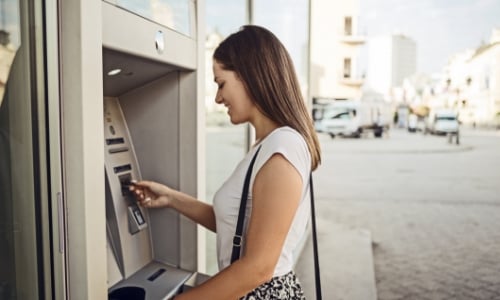9 tips to protect yourself while at the ATM
We strive to take all the necessary precautions when it comes to protecting our customers.

That being said, sometimes there are outside circumstances that we cannot control. In these instances you can take measures to protect not just your finances, but also yourself. Use these 7 tips while at the ATM to prevent some of the most common crimes that occur, robbery and identity theft.
- Stay aware of your surroundings. When you visit the ATM, be sure to check out your surroundings before beginning any transaction, especially at night. If you see anybody hovering around the ATM or the area lights are off, consider going to another location. It's always better to be safer, rather than sorry.
- Use the buddy system. It never hurts to take a friend! Have them cover your back figuratively, and literally, when visiting the ATM. Or, if you can't find someone to tag along, simply go to an ATM that receives a lot of foot traffic or has employees available nearby to help you in the case of an emergency.
- Have your card out and ready. As you approach the ATM, get your card out and ready. Standing in line shuffling through your pockets or purse will provide any potential thief the time to steal your information or money.
- Check for skimmers. Card skimmers are devices attached to the payment terminals of an ATM, which then steals a person's card information when they insert their card to withdraw money. To prevent yourself from becoming a victim of a skimmer, follow these steps:
- Check for tampering - If the card reader slot feels loose or is oddly a different color scheme from the company's branding, or the keyboard doesn't feel right (too thick, buttons don't press easily), these are signs that an ATM has been tampered with. Don't use your card at this particular ATM.
- Take precautions on the weekend - Since it's more difficult to reach any given bank's customer service on the weekends, many criminals choose to install skimmers during this period of time. Double check any ATM's you are going to use while out and about during the weekend.
- Shield your personal identification number (PIN). While completing your transaction at the ATM be sure to hide your PIN number from onlookers, this provides you with a second layer of defense should your card be stolen or lost.
- Keep the receipt. Whether you print the receipt after buying gas at the pump or hang on to receipts after transactions, keep your receipts safely stored away or dispose of them, some receipts will contain the last four digits of your card's number and may also list your personal information such as name, address, email address.
- Do not count the received cash. After withdrawing cash from your transaction, do not stick around to count out the cash. Instead wait till you get to your car or safely home to count out the funds. Counting at the ATM alerts criminals to a possible target with a large cash sum and makes it easy for them to simply snatch it out of your hands or pockets.
- Never share your personal identification number (PIN). Your PIN should be kept personal - this means no sharing with friends or family. It's also not a great idea to write your PIN down and store at home or with you in a wallet or purse. If someone steals your belongings, they'll have access to both the debit card and your PIN.
- If you're using a drive up ATM, make sure you vehicle is secure. It may feel safer to stay in your vehicle; however, you'll want to make sure your passenger windows are rolled up and all doors are locked.
We will always do the best we can to protect you, but sometimes there are things that are out of our control - be sure to remain alert and prepared while at the ATM.
Source: American Bankers Association
